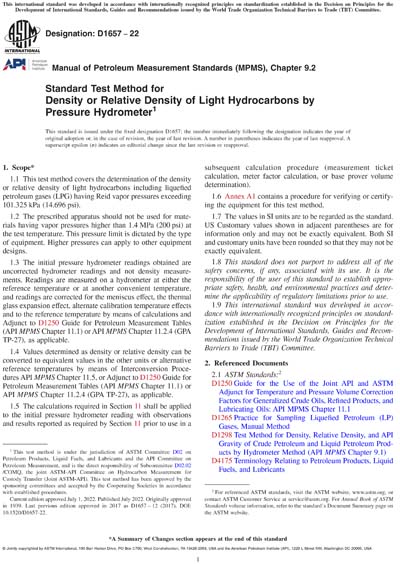Historical
ASTM D1657-22
Standard Test Method for Density or Relative Density of Light Hydrocarbons by Pressure Hydrometer
1.1This test method covers the determination of the density or relative density of light hydrocarbons including liquefied petroleum gases (LPG) having Reid vapor pressures exceeding 101.325 kPa (14.696 psi).
1.2The prescribed apparatus should not be used for materials having vapor pressures higher than 1.4 MPa (200 psi) at the test temperature. This pressure limit is dictated by the type of equipment. Higher pressures can apply to other equipment designs.
1.3The initial pressure hydrometer readings obtained are uncorrected hydrometer readings and not density measurements. Readings are measured on a hydrometer at either the reference temperature or at another convenient temperature, and readings are corrected for the meniscus effect, the thermal glass expansion effect, alternate calibration temperature effects and to the reference temperature by means of calculations and Adjunct to D1250 Guide for Petroleum Measurement Tables (API MPMS Chapter 11.1) or API MPMS Chapter 11.2.4 (GPA TP-27), as applicable.
1.4Values determined as density or relative density can be converted to equivalent values in the other units or alternative reference temperatures by means of Interconversion Procedures API MPMS Chapter 11.5, or Adjunct to D1250 Guide for Petroleum Measurement Tables (API MPMS Chapter 11.1) or API MPMS Chapter 11.2.4 (GPA TP-27), as applicable.
1.5The calculations required in Section 11 shall be applied to the initial pressure hydrometer reading with observations and results reported as required by Section 11 prior to use in a subsequent calculation procedure (measurement ticket calculation, meter factor calculation, or base prover volume determination).
1.6Annex A1 contains a procedure for verifying or certifying the equipment for this test method.
1.7The values in SI units are to be regarded as the standard. US Customary values shown in adjacent parentheses are for information only and may not be exactly equivalent. Both SI and customary units have been rounded so that they may not be exactly equivalent.
1.8This standard does not purport to address all of the safety concerns, if any, associated with its use. It is the responsibility of the user of this standard to establish appropriate safety, health, and environmental practices and determine the applicability of regulatory limitations prior to use.
1.9This international standard was developed in accordance with internationally recognized principles on standardization established in the Decision on Principles for the Development of International Standards, Guides and Recommendations issued by the World Trade Organization Technical Barriers to Trade (TBT) Committee.
ASTM International [astm]

